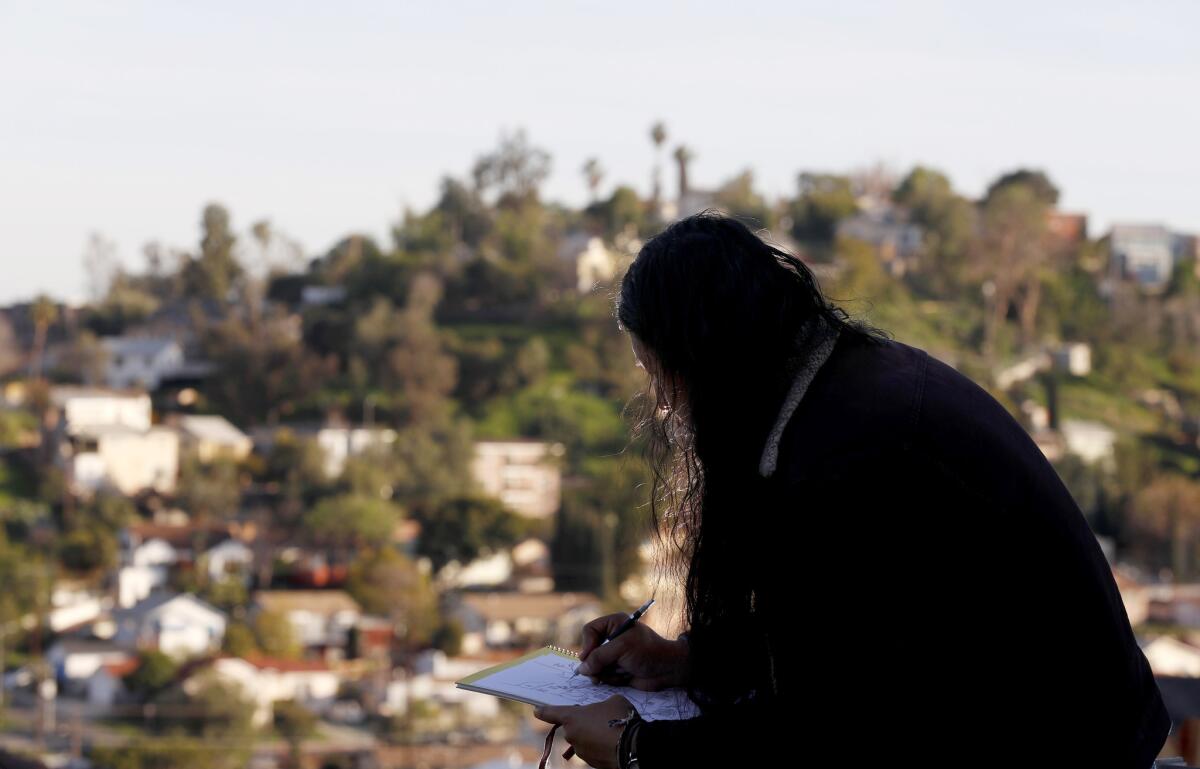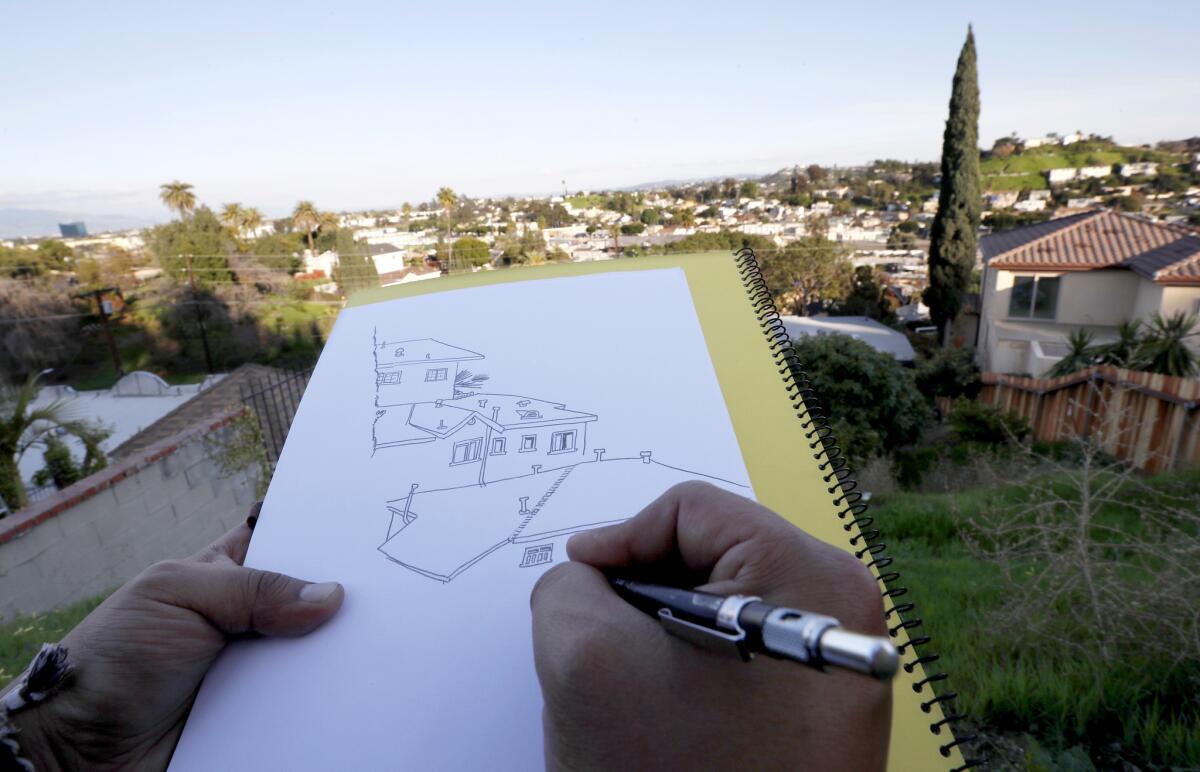An artist finds his subject in the hills of East L.A.

Manuel Lopez was 8 years old when he first noticed the hills of his East L.A. neighborhood.
Riding with his sisters in the back of his dad’s Ford LTD, he gazed out the window and lost himself in los cerros.
They were huge, the dwellings perched on them so tiny by comparison. The houses seemed to grow from the ground a little crooked — in a tangle of trees, fences, telephone poles, all teetering on the edge.
“Who lives up there?” Lopez wondered. “Why are they not falling down?”
Years later, those hills would help him find his way.
*
Growing up, Lopez and his oldest sister, Griselda, loved to compete. Who could draw the best Trix rabbit, the long-eared bunny on the cereal box?
“The winner gets $1,” their dad would tell them.
Drawing became a game Lopez played everywhere he went.
He drew elaborate stars on the wooden frame of his bunk bed and little cars inside telephone books. He traced noses on family photos and drew God and the devil deep in battle in one of his family’s precious bibles. He even drew chola eyebrows on Dopey, his dog.
Once, inspiration struck in the middle of a Super Mario Bros. video game. He grabbed a permanent marker and turned the screen into his canvas.
“What have you done?” asked his furious mother. “You ruined our TV.”
Later, when Lopez went off to a big fine art school, she liked to claim his gift came from her side of the family, from her sister Meche.
Tia Meche lives in Guadalajara and showcases her many creations in her house. She turns clear plastic cups into Santa Clauses with cotton-ball googly eyes and hats she knits by hand.
“She’s very creative,” Lopez, 34, said.

As a kid, Lopez was surrounded by murals east of the river. His favorite was on 8th and Concord.
It was a big black-and-white tribute to the Raiders, splashed on the wall of a liquor store.
“I thought it was the coolest thing in all of Los Angeles,” he said.
He found high art not in museums, books and old masters. It came from the streets, cartoons, comics and cereal boxes.
In a hallway at Garfield High School just before graduation, he saw a girl walk by carrying a folder.
On its cover was an image of a woman surrounded by giant leaves, with braids crowning her head, a monkey on her shoulder and a hummingbird on her chest.
“It struck me,” Lopez said. “It was something raw and new.”
“That’s Frida Kahlo,” a friend told him.
He searched for Kahlo at the library and studied every detail in her self-portraits, down to the soft fuzz on her upper lip. He was determined to capture her on paper.
When he took his drawing to school, his friends were amazed. Soon they began to commission their own pieces. They brought him photos of themselves as babies, of their dogs, their cats, their favorite singers. One kid asked him for a portrait of Jimi Hendrix, another of Henry David Thoreau.
Lopez charged $20 or a used Nirvana CD or a bag of Flamin’ Hot Cheetos.
“You should be an artist,” people told him.
He thought to himself, “I don’t know any artists. Those only exist in books.”
But six years later, after working at a car parts store, a church office and a school cafeteria while taking every art class offered at East Los Angeles College, he applied to the School of the Art Institute of Chicago.
“I had learned all I could learn,” Lopez said. “But I wanted to know more.”

In the Windy City, he lived in Pilsen, a Mexican neighborhood with panaderias and a big mural of the Mexican singer Ramon Ayala, in full norteno glory — thick mustache, accordion, boots.
He ate lots of beans, lots of chicharrons.
At school, he immersed himself in contemporary art. He studied Willem de Kooning and Philip Guston.
His own work was mostly abstract, heavy on bright pinks and greens and blues, colors that reminded him of home.
“That’s very exotic,” people at school would tell him. “Very tropical. Very Latin.”
Lopez felt proud, but also offended.
Once, inspired by the surfer vans he used to see as a kid when he’d visit Venice Beach, he painted: a psychedelic unicorn flying through a storm of glitter in outer space.
“Why would you paint that?” people asked at school. “That’s not your culture.”
When Lopez returned to East L.A. from Chicago in late 2010, something happened that he did not anticipate.
For the first time in his life, he felt stuck. He stopped making art.
“I knew all this stuff, but I felt like I lost something,” he said.
He needed a break.
He got a job as a teacher’s assistant in East Los Angeles College art classes. In his free time, looking for inspiration, he read a lot and went to museums and art shows. He filled sketchbooks with random things that mattered little.
Then sometime in 2013, Lopez remembered a grassy knoll close to the El Mercadito neighborhood with a sweeping view of the City Terrace hills.
When he went there one day at sundown, he felt the urge to draw, so he dug around his car and pulled out an old spiral notebook. He sketched the slanted rooftops, tiny windows, tiny doors, the cypress trees, palm trees and telephone poles — a little crooked, a little awkward, just as they seemed to him so long ago, from the back of his dad’s Ford.

These days, Lopez heads to the hills straight after work, racing the setting sun.
He goes to East L.A., El Sereno, City Terrace, a different spot each time.
He doesn’t care much for the rules he learned in art school. His lines aren’t straight. Sometimes they’re wavy and don’t connect. Midway on a rooftop, they’ll suddenly stop short. The lines remind him of the houses he draws.
“They’re not perfect,” he says, “but they’re standing.”
What matters most to him, he says, is the lives he imagines inside them.
He sees Conchita, his mom’s longtime friend who always talks about God and plants.
He sees Don Enrique, his dad’s mechanic, with his “old blue van and really greasy hands.”
He pictures the Tongva people, who inhabited these hills for thousands of years before he came along.
His drawings are black and white. The color is in their tiny details.
The kind of things others consider eyesores: ornate bars across vinyl windows, tennis shoes dangling from telephone wires, spray-painted tagging, an air conditioner strapped to a wall.
He has dozen of drawings, many of them in the trunk of his car. Sometimes people spot them on his Instagram account and offer to buy one or two.
In May, a gallery owner in Chinatown plans to exhibit his work.
When Lopez takes his place high on a slope with pencil and paper, he hears babies cry, mothers scold and cars roar by blasting Chalino Sanchez. Mockingbirds chirp, roosters crow and the evening news blares in Spanish. Sundays, church bells ring and the air is all carne asada.
On a recent evening, Lopez drove up Castleman Street in El Sereno and scanned the slopes, searching for the right spot. It was a clear day, and he could see Montebello in one direction, Alhambra in another.
He zoomed in on two tiny satellite dishes jutting out of the rooftop of a peach, stucco house.
“This is a good place to start,” he said, as he perched on a guardrail to draw.
Manuel Lopez’s exhibit at Eastern Projects Gallery in Chinatown will be May 19.
For information, contact Lopez or Eastern Projects LA.
Sign up for Essential California
The most important California stories and recommendations in your inbox every morning.
You may occasionally receive promotional content from the Los Angeles Times.








